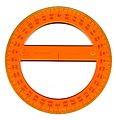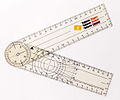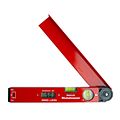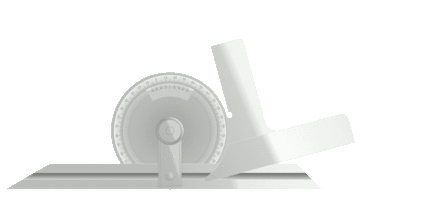Protractor
A protractor (also called a degree meter, in older usage also called a feed dog) is a simple goniometer for measuring angles or for entering an angle. It consists of a circular or semicircular disc with angular graduations. The disc can be made of plastic, strong paper or sheet metal. Common diameters are 8 to 15 cm and graduations of 1° or 0.5°, in surveying also 0.5 Gon (new degree). The accuracy is about 0.1 to 0.5° depending on the diameter of the scale.
Protractors are often integrated into drawing triangles or set squares. A triangle of nautical cutlery is regularly equipped with a protractor. More accurate protractors have a pivoting rail with scale (length division to millimeters), which can be determined at the desired angle.
With the semicircular feed dog, the mm graduation runs along the diameter. Examples for geodesy (for mapping measured points) or for cartography have large diameters of about 30 cm. Here, the scale can also be numbered in the most commonly used scale (e.g. 1:500 or 1:2000, or 1:1440 or 1:2880 for the earlier cadastral folders). In crafts, the exact measurement of an angle is usually unnecessary; here, a bevel is used to transfer an angle to a workpiece.
· Various protractors
· 
360 degree protractor
· 
Typical protractor with small ruler for school use
· 
Medical protractor
· 
electronic protractor with digital display
Protractors as we know them today came into being in the second half of the 18th century, when scientists such as Jesse Ramsden and Georg Friedrich Brander refined the previously rather imperfect instruments to such an extent that the individual graduations could hardly be distinguished by the naked eye. At that time, the preferred materials of manufacture were wood, brass, silver, copper or ivory; in the first half of the 20th century, sheet metal and celluloid were common. Today there are also electronic protractors, which usually work with a rotation sensor.
Related measuring devices are the clinometer, the theodolite, an optical protractor used in construction and land surveying, the clinometer as a simple optical protractor for determining slopes, inclines and for indirect height measurement, and the sextant as an optical protractor for navigation. In synthetic geometry, the unrestricted possibility of measuring angles, i.e. there that every line length inversibly uniquely corresponds to a class of angles, is formulated as an axiom, the protractor axiom, see → Euclidean solid.

Use of a universal protractor, vernier reading
Search within the encyclopedia